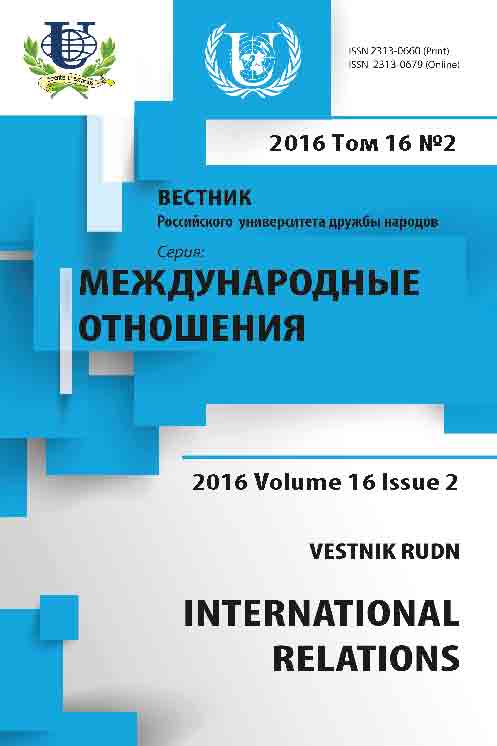Main trends of foreign policy of Georgia and some aspects of its cooperation with the People’s Republic of China
- 作者: Mailyan B.V.1
-
隶属关系:
- Russian-Armenian (Slavic) University
- 期: 卷 16, 编号 2 (2016): Africa in International Relations
- 页面: 311-322
- 栏目: Articles
- URL: https://journals.rudn.ru/international-relations/article/view/14279
如何引用文章
全文:
详细
The article considers the characteristics and key aspects of cooperation between Georgia and China. Is celebrating the success of these countries in the institutionalization of economic contacts, which is the core of Beijing's initiative to form a pool of around his project «Economic Zone - the new Silk Road». At the same time it emphasizes that the potential for cooperation between the Georgian and Chinese sides only just gaining a positive momentum. Its rapid development in the near future promises to change the configuration of some of Georgia's foreign policy doctrine, which is now fixed focus exclusively on the Western community of nations. The country of the Golden Fleece clearly looking for themselves the status of the main partner of China in the South Caucasus region. The most active participation of the Georgian side in the implementation of China's geo-economic models in the already foreseeable future promises to the official Tbilisi to make the issue of accession of Georgia to NATO and the EU is not as relevant as it is today. Georgia's foreign policy strategy will be influenced by agreements signed in the framework of the strategic partnership between China and Russia on the multi-vector model of transportation of goods and resources within the framework of the convergence of the Eurasian Economic Union and Silk Road Economic Belt.
作者简介
Beniamin Mailyan
Russian-Armenian (Slavic) University
编辑信件的主要联系方式.
Email: mailyan1968@gmail.com
National Academy of Sciences, Yerevan, Armenia
Yerevan, Armenia参考
- Babayan D., 2011. Nekotorie aspekti politiki KNR na Kavkaze. Central’naya Azia i Kavkaz. [Some aspects of China's policies in the Caucasus. Central Asia and Caucasus] Vol. 14, Iss. 1, pp. 82-93.
- Doklady Rossiyskogo Instituta Strategicheskikh Issledovaniy (RISI) [Reports of the Russian Institute of Strategic Studies (RISS).] Available at: http://www.riss.ru/upload/news/554/Reports %20of %20RISS_2012_1.pdf. (date of access: 26.06.2015)
- De Waal T., 2011. Vibor Gruzii: kakoy kurs izbrat’ v period neopredelyonnosti? [Georgia’s Choices: Charting a Future for Georgia in Uncertain Times] /perevod s angl. yaz. М. Коrobochkina. Мoscow, Centre Carnegie, 67 p.
- Маilyan B.V., 2012. Rossiysko-gruzinskiye otnosheniya i vopros chlenstva Gruzii v SNG. Istoriko-kul’turniye osnovi social’no-politicheskoy modernizacii. Sbornik nauchnikh statey.[ Russian-Georgian relations and the issue of Georgia's membership in the CIS. Historical and cultural bases of social and political modernization. Collection of scientific articles], Yerevan, Rossiysko-Armianskiy (Slavianskiy) Universitet, pp. 73-88.
- Mailyan B., 2014. From the history of the formation of the post-Soviet foreign policy orientations of the ruling elite of Georgia: a retrospective look. Contemporary Eurasia: clash of political interests /ed. by professor R.A. Safrastyan, Vol. III (1), Institute of Oriental Studies Armenian National Academy of Sciences, Yerevan, pp. 90-102.
- Potapenko V.М., 2014. KNR kak noviy meshdunarodniy donor: osobennosti politiki sodeystviya meshdunarodnomu razvitiyu. Vestnik RUDN, seriya Meshdunarodnie otnosheniya. [China as a new international donor: features of the policy of international development assistance], no.1, pp. 19-31.
- Van Czingo, Van Chshiczun, 2008. GUAM i KNR. Central’naya Azia i Kavkaz (special’niy vipusk). [GUAM and China. Central Asia and Caucasus (special issue)] no. 3-4, pp. 196-210.








